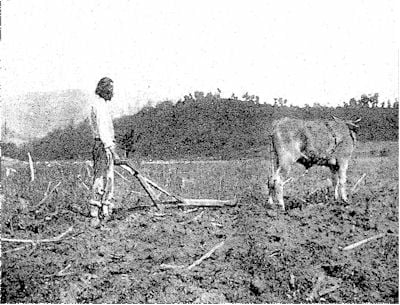The superstitions and religious extravaganzas of ancient times have almost disappeared. Lingering fancies as to witches and witchcraft crop out from time to time among these Indians, but in no more unreasonable forms than among their neighbors. The church organizations are in a languishing condition. While the people as a whole are Christian in theory and no pagan element remains, the early mission enterprises among the Cherokees have not advanced with the intelligence and physical prosperity of the people. Both Baptists and Methodists early occupied the field, and with marked success. At present the old church buildings, indicated on the map, and one adjoining the agency, all equally dilapidated, are uninviting and of no value in bad weather. Schoolhouses are used both for public worship and Sunday-school gatherings, as the population is neither numerous nor rich enough to erect and sustain independent churches. The erection by the government of a suitable building near the agency for public meetings and use upon the Sabbath by the different denominations in turn would meet the demand and prove a great benefit to the people. The Cherokees would contribute the lumber and labor necessary for its erection. Religious denominational jealousies and proselytism have had their part in this apparent religious declension, and the Indians are no less susceptible to such influences than white people. At present the rules adopted for the management of the common or district schools by Superintendent W. H. Spray, of the Cherokee training school, who has charge of all the schools as well, are decidedly in the direction of religious and moral progress throughout the territory. No teacher is employed who is not a Christian man or woman, but no preference in the selection of teachers is shown as to the different evangelical denominations of the Protestant church. There are no Catholics among the Cherokees. The school buildings are also readily opened for religious meetings, and in addition to this the training school, while nominally under control of the Friends, is thoroughly catholic in spirit and wholly without bigotry or proselytism in its management. The attendance at this school habitually of about one-fourth of the children of school age, where religious training forms a cardinal feature of the work, has its wholesome effect elsewhere.
Rev. S. G. Owen, of the West North Carolina Baptist convention, preaches three times each month in some one of the districts, receiving a salary of $500 per annum. Connected with the Baptist church as Indian helpers or ministers are John Jackson, of Graham County, and Suate Owl, John Kamut, and Armstrong Cornsilk, of Swain County. The contributions, as reported by Mr. Owen, average about $1 a Sabbath, which is applied to the allowance from the Baptist convention. The communicants, widely scattered, and consequently irregular in their attendance at church, are estimated at 100, many once active members being counted as backsliders or indifferent. Rev. J. A. Wiggins, of the Methodist church, visits the territory once a month, and Stamford George, a Cherokee minister, is one of the most consistent and active workers of that denomination. John Long also does ministerial work. Rev. Mr. Bird, already referred to, and worthy of special honor for a long life of self-sacrificing toil in this field, where he will spend his remaining years, considers a central place of worship of great importance, and, with Mr. Owen, regards the present a fit time for increased effort to reach the Cherokee families for good. Both denominations should increase their means of usefulness among the Cherokees, and they should receive a liberal support. The absence of the Cherokee from the criminal courts, the uniform observance of the marriage rite, the character and development of the schools, and the industry of the people are signs of real progress. Evidence on file at the Interior department shows that illegitimate births are less frequent than among the white people. The recent determination of the leading Cherokee councilmen and citizens to make morality, a fair education, and temperance the essential prerequisites of their candidate for principal chief at the all election of 1891 is a true index to the purpose of this people as to their future. There are no formal temperance organizations among the Eastern Band of Cherokees, but intemperance is not common. Among those who have indulged to excess the principal chief has been the most prominent, but his influence, once paramount, has now little effect, and three- fourths of the council of the nation are opposed to his habits and policy. He declares his purpose, however, to reform and present a better example. Heretofore he has been a man of much pride and dignity, and he might still do much for this people if in full accord with educational, moral, and religious progress. At the training school, which is the center of interest, no employ6 is retained who is either intemperate or profane. This institution, with its many pupils and its liberal market arrangements with the Indians, exerts an elevating and wholesome influence in all directions.





